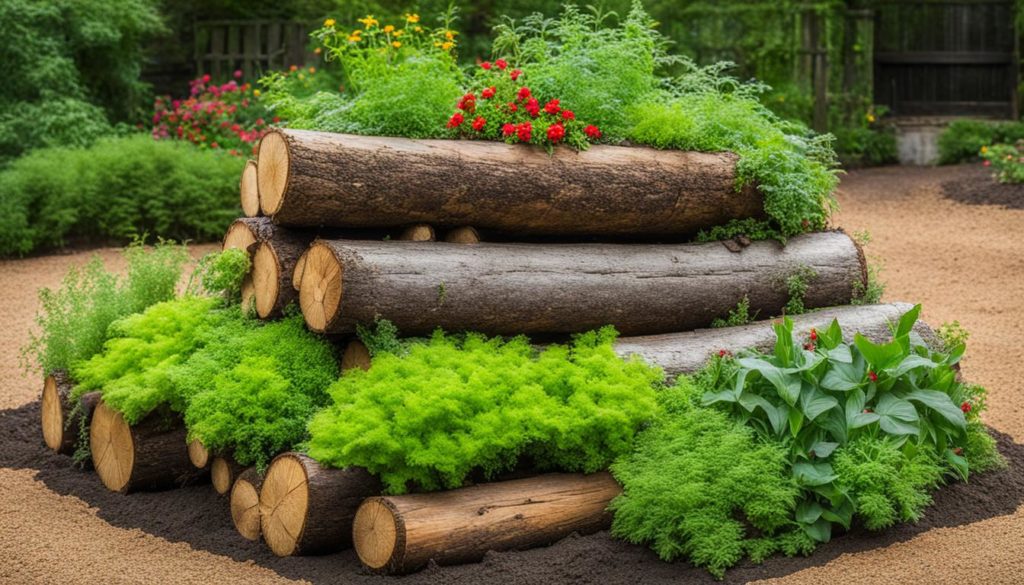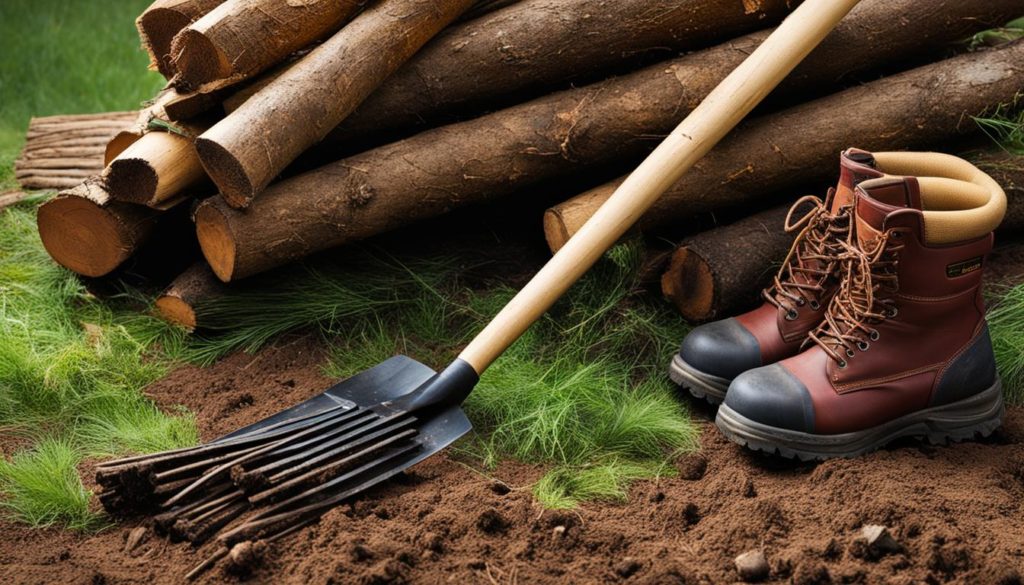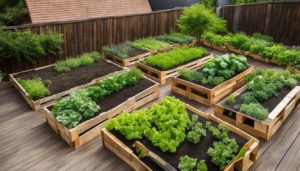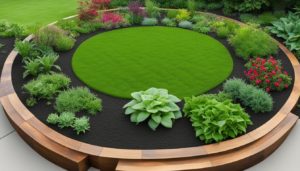Are you looking to build a raised garden bed? Consider using logs for a natural and eco-friendly option. Raised garden beds made with logs offer several advantages, including easy access, excellent drainage, and protection against weeds and pests. Not only do logs add an attractive design element to your garden, but they also contribute organic matter to the soil over time. Whether you’re a seasoned gardener or just starting out, building your own raised garden bed with logs is a simple and rewarding project.

Key Takeaways:
- Raised garden beds made with logs provide easy access, good drainage, and protection against weeds and pests.
- Logs add visual appeal to your garden and contribute organic matter to the soil over time.
- Building a raised garden bed with logs is a simple and eco-friendly option.
- Consider the benefits of hugelkultur technique to enhance your raised garden bed.
- Choose long-lasting woods like cedar, redwood, or cypress for your log raised garden bed.
The Benefits of Raised Garden Beds with Logs
Raised garden beds made from logs provide numerous benefits for gardeners. They act as a barrier to weeds and encroachments from the surrounding area, making it easier to maintain a weed-free garden. The raised beds also make gardening more comfortable by keeping plants at a convenient height, reducing strain on the back and knees. Additionally, logs can deter ground-dwelling pests such as insects and rodents, adding an extra layer of protection for your plants.
One of the key advantages of raised garden beds with logs is their ability to prevent weed growth. The raised structure, combined with the presence of logs, creates physical barriers that hinder weed seeds from reaching the soil. This helps to minimize weed growth and reduces the need for constant weeding. By having a weed-free garden bed, you can focus more on nurturing your plants and enjoying your gardening experience.
Furthermore, raised garden beds with logs provide improved accessibility. The elevated design allows you to tend to your plants without bending down or kneeling, making it easier on your back and knees. This is especially beneficial for individuals with mobility issues or those who prefer a more ergonomic gardening experience. With raised beds, you can comfortably reach your plants for watering, pruning, and harvesting.
Another advantage of gardening with logs is the natural deterrent they provide against ground-dwelling pests. The rough texture and scent of logs can discourage insects and small animals from approaching your plants. By incorporating logs into your raised garden bed, you can create a protective barrier that helps to safeguard your crops from potential damage caused by pests.
Materials Needed for Building a Raised Garden Bed with Logs
To create your own raised garden bed with logs, you will need the following materials:
- 8×8′ logs
- Cardboard
- Rebar
- Landscaping fabric
- Garden soil
- Shovel
- Drill
- Staple gun
When it comes to selecting the right logs, cedar logs are a popular choice due to their durability and natural resistance to rot. In Australia, consider using cypress pine logs, which are both termite and rot-resistant. These materials will ensure the longevity and stability of your raised garden bed.
Materials for Building a Raised Garden Bed:
| Materials | Description |
|---|---|
| 8×8′ logs | Durable and stable logs for constructing the garden bed |
| Cardboard | Used as a weed barrier |
| Rebar | Secures the logs at the corners |
| Landscaping fabric | Helps prevent soil seepage |
| Garden soil | High-quality soil for optimal plant growth |
| Shovel | Used for digging and moving soil |
| Drill | Required for drilling holes in the logs for rebar insertion |
| Staple gun | Used to secure the landscaping fabric to the interior sides of the bed |

By gathering these materials, you’ll have everything you need to successfully build your own raised garden bed with logs. This will enable you to create a sustainable and eco-friendly gardening space while enjoying the benefits of enhanced drainage, weed control, and attractive design.
Steps to Build Your Raised Garden Bed with Logs
Building a raised garden bed with logs is a simple and rewarding project that can enhance your gardening experience. Follow these step-by-step instructions to construct your own raised garden bed with logs:
1. Choose a Suitable Location
Begin by selecting a suitable location for your raised garden bed. Look for an area with adequate sunlight and good drainage. Avoid placing it too close to trees or structures that may provide excessive shade or obstruct the growth of your plants.
2. Measure and Mark the Dimensions
Measure and mark the dimensions for your garden bed using the 8×8′ logs. Ensure that the area is large enough to accommodate the plants you intend to grow while leaving ample space for easy access and maintenance.
3. Clear the Marked Area
Before assembling your garden bed, clear the marked area of any debris, rocks, or weeds. Remove any obstacles that may interfere with the construction process or hinder the growth of your plants.
4. Lay Cardboard as a Weed Barrier
To prevent the growth of weeds, lay cardboard on the ground within the marked area. The cardboard will act as a barrier, suppressing any existing weeds and preventing new ones from sprouting through your garden bed.
5. Assemble the Logs
Stack the logs securely on top of the cardboard, forming the walls of your raised garden bed. Ensure that the logs are level and firmly aligned with each other. This will create a sturdy structure that can withstand the weight of the soil and the pressure exerted by the plants.
6. Secure the Logs Together
Use rebar to secure the logs together at the corners. Insert the rebar through the logs, ensuring a tight and secure connection. This will prevent the logs from shifting or separating over time, maintaining the integrity of your garden bed.
7. Line the Interior Sides
Line the interior sides of the bed with landscaping fabric to prevent soil seepage. This will help contain the soil within the raised bed and prevent erosion. Cut the fabric to fit the dimensions of your garden bed and staple it to the inside walls.
8. Fill the Bed with Garden Soil
Fill the bed with quality garden soil, ensuring even distribution throughout the entire space. The soil should be suitable for the types of plants you intend to grow, providing adequate nutrients and drainage. Level the soil surface to create a smooth planting area.
9. Plant Your Desired Vegetables and Herbs
Now that your raised garden bed is ready, it’s time to plant your desired vegetables, herbs, or other plants. Follow the recommended planting instructions for each specific plant, considering factors such as spacing, sunlight requirements, and watering needs.
10. Water and Maintain Your Garden
Water your garden bed regularly, ensuring that the soil remains adequately moist but not waterlogged. Monitor the moisture levels and adjust your watering schedule accordingly. Additionally, maintain your garden by weeding as necessary, removing pests, and providing necessary care for the plants to thrive.
By following these steps, you can successfully build your own raised garden bed with logs and create a thriving and productive garden space for your plants to flourish.
Enhancing Your Raised Garden Bed with Hugelkultur Technique
Hugelkultur is a permaculture gardening technique that can be used to enhance the productivity and sustainability of your raised garden bed made with logs. By incorporating this method, you can conserve water, improve soil fertility, and promote a more self-sustaining ecosystem within your garden.
The concept behind hugelkultur involves burying dead logs and organic material beneath the soil surface. As these logs decompose over time, they act as sponges, absorbing and retaining moisture in the soil. This helps to reduce the frequency and amount of watering required for your plants, making your garden more resilient during periods of drought or water scarcity.
In addition to water conservation, the decomposition process of the logs releases valuable nutrients into the soil, providing a constant source of nourishment for your plants. This natural fertilization method can improve the overall fertility of the soil, leading to healthier and more abundant harvests.
Furthermore, hugelkultur beds create a more aerated soil environment, allowing for better root development and nutrient absorption. The logs also provide habitat and food sources for beneficial organisms, such as earthworms and beneficial bacteria, which contribute to the overall health of your garden ecosystem.
Table: Comparison of Hugelkultur and Traditional Raised Bed Gardening
| Hugelkultur | Traditional Raised Bed | |
|---|---|---|
| Water Conservation | Excellent | Good |
| Soil Fertility | High | Medium |
| Aeration | Excellent | Good |
| Long-Term Sustainability | High | Medium |
| Beneficial Organism Habitat | High | Low |
Choosing the Right Wood for Your Log Raised Garden Bed
When it comes to building a log raised garden bed, selecting the right type of wood is crucial for ensuring its longevity and durability. You want to choose a wood that is naturally long-lasting and resistant to rot. Here are some options to consider:
Cedar
Cedar is a popular choice for log raised garden beds due to its natural durability and resistance to decay. It has natural oils and compounds that make it resistant to rotting and insect infestations. Cedar also weathers well over time, maintaining its strength and beauty.
Redwood
Redwood is another excellent choice for log raised garden beds. It is naturally resistant to decay and rot, making it an ideal option for outdoor construction. Redwood is known for its rich color and natural beauty, adding an attractive aesthetic to your garden.
Cypress
Cypress is a rot-resistant wood that is commonly used in outdoor applications, including log raised garden beds. It has natural oils that protect it from decay and insects, ensuring its durability over time. Cypress also has a beautiful grain pattern that adds visual appeal to your garden.
Black Locust
Black locust is an excellent choice for those seeking a highly durable and rot-resistant wood. It is known for its strength and ability to withstand harsh weather conditions. Black locust logs can last for decades without any chemical treatments, making them a sustainable option for log raised garden beds.
| Wood Type | Longevity | Resistance to Rot | Resistance to Insects | Visual Appeal |
|---|---|---|---|---|
| Cedar | High | High | High | Beautiful color and grain pattern |
| Redwood | High | High | High | Rich color and natural beauty |
| Cypress | High | High | High | Distinctive grain pattern |
| Black Locust | High | High | High | Strong and durable |
When choosing the right wood for your log raised garden bed, consider the specific characteristics of each type, as well as their availability in your area. By selecting a rot-resistant wood, you can ensure that your garden bed will stand the test of time and provide a long-lasting home for your plants.
Maintaining and Caring for Your Raised Garden Bed
Maintaining your raised garden bed is crucial for the long-term health and productivity of your plants. By following a regular maintenance routine, you can ensure that your plants receive the care they need to thrive. Here are some key tasks to keep in mind:
Watering Plants
Proper watering is essential for the success of your garden bed. Monitor the moisture level of the soil regularly and water your plants when the top few inches of soil are dry. It’s important to strike a balance and avoid overwatering, as it can lead to root rot and other issues. Consider using a soaker hose or drip irrigation system to deliver water directly to the roots while reducing water waste.
Weeding
Weeds can compete with your plants for nutrients, water, and sunlight. Regular weeding is necessary to keep your garden bed free from unwanted vegetation. Take the time to remove weeds by hand, ensuring that you remove the entire root system. Applying a layer of mulch or straw around your plants can also help suppress weed growth by blocking sunlight and preventing weed seeds from germinating.
Fertilizing and Adding Organic Matter
To maintain soil fertility and promote healthy plant growth, it’s important to replenish nutrients regularly. Consider adding organic matter such as compost or well-rotted manure to your garden bed each season. This will not only enrich the soil but also improve its structure and moisture-retaining capacity. Follow the recommended application rates for different types of organic matter to avoid over-fertilization.
With proper maintenance and care, your raised garden bed will continue to provide you with bountiful harvests season after season. Stay vigilant in watering, weeding, and fertilizing, and your plants will reward you with vibrant growth and abundant produce.
Conclusion
In conclusion, building your own raised garden bed with logs offers numerous benefits for both beginners and experienced gardeners. The raised beds provide easier access, better drainage, and protection against weeds and pests, creating an ideal environment for your plants to thrive.
Furthermore, logs contribute to the fertility of the soil over time, enriching it with organic matter as they decompose. This natural process improves the overall health of your garden and enhances plant growth. Additionally, the use of logs adds a rustic and visually appealing element to your outdoor space.
By following the step-by-step guide provided and considering enhancements such as the hugelkultur technique, you can create a sustainable and productive garden bed. Embrace the natural charm of gardening with a raised bed made from logs and enjoy the beauty and functionality it brings to your garden. Start building your own raised garden bed with logs today and experience the numerous benefits it offers!
FAQ
What are the advantages of raised garden beds made with logs?
Raised garden beds made with logs offer great drainage, ease of access, and protection against weeds and pests.
What materials do I need to build a raised garden bed with logs?
You will need 8×8′ logs, cardboard, rebar, landscaping fabric, garden soil, shovel, drill, and staple gun.
Can I use any type of wood for my log raised garden bed?
It is recommended to use naturally long-lasting wood options such as cedar, redwood, cypress, or black locust for better durability.
How do I build a raised garden bed with logs?
Clear the area, lay cardboard as a weed barrier, assemble the logs securely, line the bed with fabric, fill with garden soil, and plant your desired plants.
What is the hugelkultur technique and how can it enhance my raised garden bed?
Hugelkultur involves burying dead logs and organic material in the bed to conserve water and provide nutrients. This technique improves soil fertility, aeration, and requires less soil.
How should I maintain and care for my raised garden bed?
Regular watering, monitoring for pests and diseases, and weeding are important for maintaining the health and productivity of your garden bed. Adding organic matter and compost can also help maintain soil fertility.


